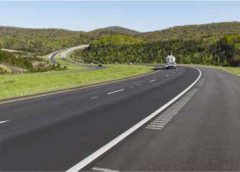As the U.S. Interstate Highway System turns 60 years old, it faces increasing congestion, unprecedented levels of travel – particularly by large trucks – and insufficient funding to make needed repairs and improvements.
The nation’s most critical transportation link continues to save lives with its enhanced safety features and is largely well-preserved, but an aging Interstate system will increasingly require more long-term, costly repairs, according to a new report released by TRIP, a Washington, D.C.-based national transportation organization.
The TRIP report, “The Interstate Highway System Turns 60: Challenges to Its Ability to Continue to Save Lives, Time and Money,” finds that while the Interstate Highway System represents only 2.5 percent of lane miles in the U.S., it carries 25 percent of the nation’s vehicle travel.
The system is increasingly congested, with truck travel growing at a rate twice that of overall Interstate travel. And, while the nation’s Interstates tend to be in better condition than other roads and bridges, the aging system lacks the required funding for needed improvements and repairs.
The top 10 states whose Interstate systems have the highest levels of congestion, the largest share of large truck travel, the highest increase in travel from 2000 to 2014, the highest share of pavements in poor and mediocre condition, the highest rate of structurally deficient bridges, and the largest number of lives saved annually, are: California, Maryland, New Jersey, Rhode Island, Delaware, Massachusetts, Hawaii, Connecticut, Florida and Minnesota.
The current backlog of needed improvements to the Interstate Highway System, as estimated by the U.S. Department of Transportation, is $189 billion. The nation’s current transportation investment is less than two-thirds (61 percent) of the amount needed to keep Interstates in good condition and make the improvements necessary to meet the nation’s growing need for personal and commercial mobility.
And, while the recently enacted federal surface transportation program, the Fixing America’s Surface Transportation (FAST Act) provides a modest increase in spending it lacks a long-term, sustainable revenue source. By 2020, the shortfall into the nation’s Highway Trust Fund will be $16 billion annually.
Since 2000 travel on the Interstate system is increasing two times faster than new lane capacity is being added. As a result, 43 percent of urban Interstate highways are considered congested during peak hours and the average annual amount of travel per Interstate lane mile increased by 11 percent from 2000 to 2014. Travel by combination trucks on the Interstate increased by 29 percent from 2000 to 2014, more than double the 14 percent rate of growth for all Interstate vehicle travel during the same period.
Travel on the nation’s Interstate highways has surged since 2014. In 2015, vehicle miles of travel on the Interstate Highway System was four percent higher than in 2014 and through the first three months of 2016 travel on the Interstate Highway System was five percent higher than during the first three months of 2015.
The design of the Interstate – which includes a separation from other roads and rail lines, a minimum of four lanes, paved shoulders and median barriers – makes it more than twice as safe to travel on as all other roadways. The fatality rate per 100 million vehicle miles of travel on the Interstate in 2014 was 0.54, compared to 1.26 on non-Interstate routes.
TRIP estimates that the Interstate Highway System saved 5,359 lives in 2014, based on an estimate of the number of additional fatalities that would have occurred had Interstate traffic been carried by other major roadways, which often lack the safety features common to Interstate routes.
“The long-term vision that helped establish the current Interstate system 60 years ago is needed again today,” said Will Wilkins, TRIP’s executive director. “In order to maintain personal and commercial mobility, transportation investment and a sustainable, long-term funding source for the federal surface transportation program must remain a priority.”

